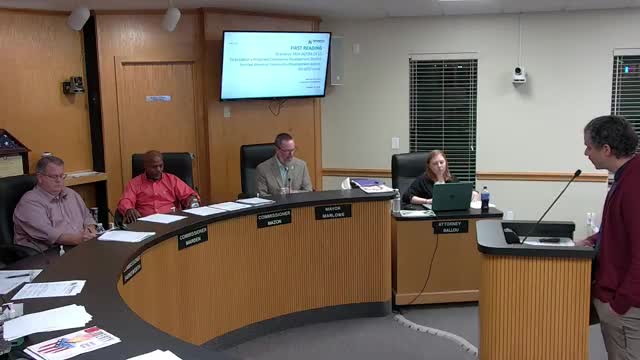New Community Development District Proposal Sparks Local Debate
October 14, 2024 | City of Newberry , Alachua County, Florida
This article was created by AI summarizing key points discussed. AI makes mistakes, so for full details and context, please refer to the video of the full meeting. Please report any errors so we can fix them. Report an error »

In a recent city commission meeting, officials discussed the establishment of the West Elm Community Development District (CDD) in Newberry, Florida. The CDD aims to facilitate public financing for infrastructure improvements in the area, allowing developers to issue bonds to fund construction projects.
John Paul Perez from the community development department presented the ordinance for the CDD, emphasizing its role as a special taxing district. He explained that the CDD would enable deeper investment in local infrastructure, potentially enhancing property values and community amenities. The initial board of supervisors for the district will consist of five members, typically the developers, but will transition to an elected board after five years.
Commissioners raised concerns about the implications of CDDs, particularly regarding their financial structure and potential confusion among residents. Questions were posed about the longevity of CDDs, their ability to levy taxes, and the responsibilities of residents regarding debt assessments. Wes Haber, a legal expert on CDDs, clarified that while the CDD can issue bonds for up to 30 years, it operates independently of the city’s financial obligations. The debt is secured solely by the real property within the district, meaning the city is not liable for any defaults.
The discussion also touched on the operational aspects of CDDs, including their governance and maintenance responsibilities. CDDs are subject to public meeting laws and must adopt budgets annually, ensuring transparency in their operations. However, concerns were voiced about the potential for confusion between CDD responsibilities and those of the city, particularly regarding infrastructure maintenance.
Overall, the commission expressed cautious optimism about the CDD model, recognizing its potential benefits for developers and residents alike while acknowledging the need for clear communication to avoid misunderstandings in the community. The ordinance for the West Elm CDD is currently undergoing its required advertisement cycle, with further readings expected before final approval.
John Paul Perez from the community development department presented the ordinance for the CDD, emphasizing its role as a special taxing district. He explained that the CDD would enable deeper investment in local infrastructure, potentially enhancing property values and community amenities. The initial board of supervisors for the district will consist of five members, typically the developers, but will transition to an elected board after five years.
Commissioners raised concerns about the implications of CDDs, particularly regarding their financial structure and potential confusion among residents. Questions were posed about the longevity of CDDs, their ability to levy taxes, and the responsibilities of residents regarding debt assessments. Wes Haber, a legal expert on CDDs, clarified that while the CDD can issue bonds for up to 30 years, it operates independently of the city’s financial obligations. The debt is secured solely by the real property within the district, meaning the city is not liable for any defaults.
The discussion also touched on the operational aspects of CDDs, including their governance and maintenance responsibilities. CDDs are subject to public meeting laws and must adopt budgets annually, ensuring transparency in their operations. However, concerns were voiced about the potential for confusion between CDD responsibilities and those of the city, particularly regarding infrastructure maintenance.
Overall, the commission expressed cautious optimism about the CDD model, recognizing its potential benefits for developers and residents alike while acknowledging the need for clear communication to avoid misunderstandings in the community. The ordinance for the West Elm CDD is currently undergoing its required advertisement cycle, with further readings expected before final approval.
View full meeting
This article is based on a recent meeting—watch the full video and explore the complete transcript for deeper insights into the discussion.
View full meeting